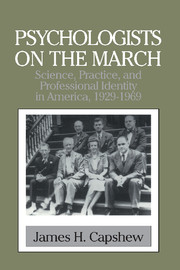Book contents
- Frontmatter
- Contents
- Acknowledgments
- List of Abbreviations
- Introduction: The Psychologists' War
- Interlude I
- 1 Growing Pains: After the Great War
- 2 Mobilizing for World War II: From National Defense to Professional Unity
- 3 Home Fires: Female Psychologists and the Politics of Gender
- Interlude II
- 4 Sorting Soldiers: Psychology as Personnel Management
- 5 Applied Human Relations: The Utility of Social Psychology
- 6 From the Margins: Making the Clinical Connection
- 7 Engineering Behavior: Applied Experimental Psychology
- Interlude III
- 8 A New Order: Postwar Support for Psychology
- 9 Remodeling the Academic Home
- Interlude IV
- 10 The Mirror of Practice: Toward a Reflexive Science
- 11 Beyond the Laboratory: Giving Psychology Away
- Interlude V
- Epilogue: Science in Search of Self
- Index
Epilogue: Science in Search of Self
Published online by Cambridge University Press: 06 July 2010
- Frontmatter
- Contents
- Acknowledgments
- List of Abbreviations
- Introduction: The Psychologists' War
- Interlude I
- 1 Growing Pains: After the Great War
- 2 Mobilizing for World War II: From National Defense to Professional Unity
- 3 Home Fires: Female Psychologists and the Politics of Gender
- Interlude II
- 4 Sorting Soldiers: Psychology as Personnel Management
- 5 Applied Human Relations: The Utility of Social Psychology
- 6 From the Margins: Making the Clinical Connection
- 7 Engineering Behavior: Applied Experimental Psychology
- Interlude III
- 8 A New Order: Postwar Support for Psychology
- 9 Remodeling the Academic Home
- Interlude IV
- 10 The Mirror of Practice: Toward a Reflexive Science
- 11 Beyond the Laboratory: Giving Psychology Away
- Interlude V
- Epilogue: Science in Search of Self
- Index
Summary
The postwar alliance for scientific professionalism began to peak around 1970 as the distinctive contours of the psychology community began to merge with the cultural landscape of America. A seemingly limitless market for psychological expertise enabled the profession to continue its remarkable expansion, with no end in sight. In 1970 membership in the American Psychological Association reached more than 30,000, an increase of nearly a hundred-fold over the span of a single professional lifetime.
By this time scientific interests and social concerns had coalesced around the study of personality and the concept of the self. Interest in personality theory was high among academic psychologists, reinforced by the “golden age” in the popularization of psychoanalytic ideas in the postwar period. Possessing vast interpretive flexibility, the self was constructed as an object of research and a locus of personal and cultural concern. After disappearing for decades from the psychological literature, theoretical and empirical studies of the self proliferated after the war. Between 1940 and 1970 some two thousand publications related to the concept of the self appeared.
The cultural preoccupation with the self was already well established when writer Tom Wolfe christened the 1970s the “Me Decade.” In a series of brilliant essays he captured the widespread and intense self-absorption of the American middle class that was associated with sexual liberation, recreational drug use, psychotherapeutic and religious cults, and various other forms of self-indulgence.
- Type
- Chapter
- Information
- Psychologists on the MarchScience, Practice, and Professional Identity in America, 1929–1969, pp. 263 - 266Publisher: Cambridge University PressPrint publication year: 1999



